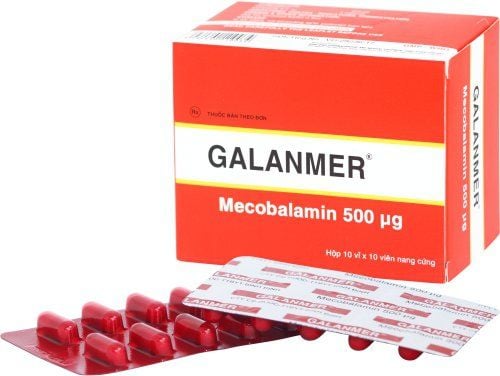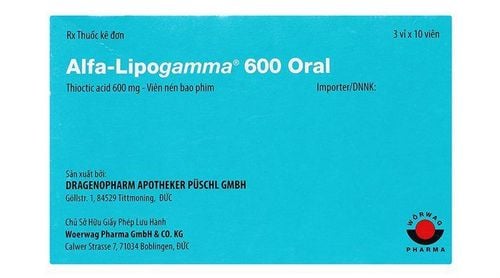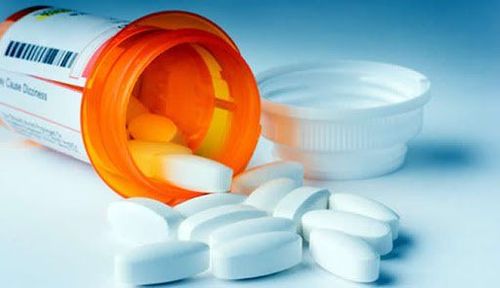This is an automatically translated article.
Lipotocin drug with the main ingredient is Thioctic acid 300 mg, which is commonly used in the treatment of sensory disorders caused by polyneuropathy common in people with diabetes. Learn the necessary information about the ingredients, uses and side effects of Lipotocin to help improve the effectiveness of treatment.
1. What is Lipotocin?
Lipotocin drug is prepared in the form of a solution for injection of 12 mL, with the main ingredients including:
Active ingredients: Thioctic acid (in the form of Thioctic acid tromethamine) content of 300 mg. Excipients: Just enough 1 ampoule 12 mL Mechanism of action
Thioctic acid is an active ingredient that acts as a coenzyme of protein complexes: Alpha Ketoglutarate Dehydrogenase, Pyruvate dehydrogenase, Amino acid dehydrogenase. Patients with diabetes, cirrhosis, atherosclerosis, and diabetic neuritis often have significant reductions in these complexes.
Thioctic acid supports insulin in the consumption of glucose in tissues, and increases the synthesis of glycogen in the liver. Since then, this active ingredient can reduce serum glucose in people with diabetes.
Thioctic acid, when in contact with nerve cells, will help create axons that strengthen the connection of nerve cells. In addition, this active ingredient also inhibits the accumulation of free radicals, thereby helping patients with diabetic nerve damage reduce swelling, pain, itching and numbness.
2. What are the effects of Lipotocin?
What does Lipotocin do? Lipotocin is used in the treatment of symptoms caused by peripheral nerve damage in patients with frequent urination.3. Contraindications of Lipotocin
Contraindications of Lipotocin drug in the following cases:
Patients with hypersensitivity to any component of Lipotocin. History of allergy to drugs containing the active ingredient Thioctic acid.
4. Dosage and how to use Lipotocin
In the course of treatment, Lipotocin is often used in combination with drugs containing oral Thioctic acid. Specific dosage is as follows:
Adults
Attack dose: Mix 2 ampoules (24 ml) of Lipotocin with 50-100 ml of 0.9% physiological saline solution. IV infusion over at least 30 minutes. Use for 2-4 weeks. Maintenance dose (tablets): Take 300-600 mg Thioctic acid/time x 2 times/day. Children: Not recommended for use.
Note: When using Lipotocin, it requires medical supervision, so patients and family members are not allowed to buy drugs for their own use.
5. Notes when using Lipotocin
Side effects encountered
Using Lipotocin in high doses or for a long time may encounter the following undesirable effects.
Common: Blood glucose disorder, hypoglycemia causing dizziness, headache, blurred vision and sweating. Rare: Gastrointestinal disturbances such as nausea, vomiting, gastroduodenal pain. Neurological symptoms such as altered or decreased taste. Skin disorders such as allergic rash, urticaria, pruritus, severe purpura due to thrombocytopenia, anaphylaxis. Patients should stop taking the drug as soon as they detect the above symptoms after using Lipotocin. When patients and family members feel abnormal signs, they should immediately notify the doctor for timely treatment.
Notes on the use of Lipotocin in subjects
Caution when using Lipotocin in the following cases: The dose should be reduced for people with diabetes combined with glucose intolerance. Pregnant or lactating women: Studies showing harmful effects when using Lipotocin in this population are very limited. Therefore, the use of Lipotocin on these subjects must be very cautious and must be approved by the doctor. Using Lipotocin on drivers or workers who operate machinery usually does not experience side effects.
6. Lipotocin drug interactions
Interactions with other drugs
Cisplatin will be inactive when used with Lipotocin. Combination of Lipotocin with insulin-containing drugs can lower blood sugar. Therefore, it is necessary to regularly check the patient's blood sugar when deciding to combine these two drugs. Avoid using Lipotocin with drugs containing Iron, Magnesium, dairy products with Calcium because it can form metal complexes. Food Interactions
Alcohol is a risk factor for neurological diseases, so alcohol reduces the effectiveness of Lipotocin. Above is an overview of ingredients, dosage, uses and notes when using Lipotocin. In order to avoid side effects of the drug, patients, family members and doctors need to coordinate in monitoring cases of Lipotocin use in treatment.
Follow Vinmec International General Hospital website to get more health, nutrition and beauty information to protect the health of yourself and your loved ones in your family.
Please dial HOTLINE for more information or register for an appointment HERE. Download MyVinmec app to make appointments faster and to manage your bookings easily.













